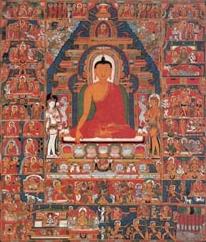Buddhism at a Glance

Buddhism originated in the 6th century B.C.E. in India, spread south to Sri Lanka, Southeast Asia, Java, and Sumatra, and north to the Himalayan region, China, Korea, Japan, and Tibet. Beginning in the 19th century, Buddhist teachings were carried to Europe and the Americas as well as parts of Africa and Australia. Unlike most of the world’s other great traditions, Buddhism is not based on any conception of a Supreme Being or Godhead. Rather than depending on God’s help to deliver us from evil and suffering (which is one view of theistic, or God-based, religions) Buddhism teaches reliance on human effort to relieve suffering. The Buddha is considered to be a historical figure, a human being who achieved great enlightenment, but not divine.
Although the Buddha taught no reliance on a Supreme Being, he nonetheless accepted much of the existing worldview of ancient India, with its panoply of gods and demons. In Buddhist artwork and scriptures, the Buddha is sometimes portrayed as preaching to or interacting with various deities. And many Buddhists venerate the historical Buddha almost like a god, while revering other earthly and celestial beings who have reached enlightenment in a manner similar to the way Westerners or Hindus worship God. How are we to understand this apparent contradiction?
Perhaps we can begin by noting that modern Buddhists practice their faith in different ways, as do Jews and Christians. For example, a fundamentalist Southern Baptist, who believes in the literal truth of every word of the Bible, and a Unitarian Universalist, who takes the scripture as largely metaphorical, are both Christians. For many Asian Buddhists, elements of the supernatural surround and suffuse their religion, partly the result of Buddhism’s having for so many centuries existed alongside the folk religions of India and China, which are resplendent with gods and goddesses, demons and ghosts and all manner of supernatural happenings. Other Buddhists, particularly Western converts to Zen, choose to follow teachers who stress the nontheistic core of Buddhism, with its reliance on personal effort to achieve self-realization. Still others interpret the teachings regarding celestial beings, demons, paradises and hells, especially as taught by Tibetan Buddhists, as metaphors for various psychological and spiritual states, images that help them in their practice but that they do not need to take literally.
The Buddha also seemed to accept the prevailing Hindu beliefs in reincarnation and karma found in the Upanishads, although he altered the concepts as he incorporated them into his own philosophy. And so he didn’t essentially question the Hindu vision of samsara, the Wheel of Existences with its continuous cycle of rebirth over thousands of lifetimes. In fact, according to some scholars, the Buddha held a view of the gods similar to that of the Greeks, feeling that the gods suffered from the same frailties and failings as humanity, and that their state was actually inferior to that of humans because only in a human lifetime can one achieve enlightenment.
Karma and Reincarnation
On the other hand, the Buddha rejected the Upanishadic concept of the Atman, or individual soul, that seeks to realize its oneness with Brahman, the Hindu name for the Godhead. The Buddha conceived of individuals as dynamic aggregates of various states, or skandas — the constituents of personality including the body-mind, feelings, ideas, subconscious predispositions, and conscious awareness — which dissolve and are reconfigured constantly (much the way medical science now tells us that every cell of our body dies and is recreated over a span of several years). He believed that one has no permanent, identifiable soul, a doctrine known as anatta or anatman. For the Buddha the mistaken identification of humanity with an individual, unchanging identity fixed in time is the root cause of all suffering and, ultimately, of death. This teaching along with its corollary, compassion for all sentient beings, make up the core of Buddhist Dharma, or collective teachings. Its numerous texts — perhaps more than any other religious tradition — and extremely complex spiritual practices and psychological analyses are all predicated on this basic insight.
The Buddha accepted the notion of karmic transfer from one form of existence to the next, but he saw each of these successive forms of existence as a continuity of moral development toward completeness rather than as an individual “personality” or soul — today we might call this conditioning. Different philosophical schools offer various explanations of how the law of karma functions while still maintaining the cardinal Buddhist position of no permanent, intrinsic identity. One way of stating Buddhist teaching might be to say that certain tendencies are created in the subtle structure of our being by all of our past actions, and those tendencies — as constantly changing and impermanent as the cells of our physical body — are what are transferred across limitless lifetimes.
But the Buddha found no useful purpose in such speculation since it would not lead to release from suffering. As one scholar put it, Buddha never taught that there is no “self,” only that such a self cannot be understood. Since he didn’t find theological disputation helpful in achieving liberation, the Buddha maintained a “noble silence” about metaphysical questions as to whether the universe is eternal or infinite, whether an enlightened being continues to exist in some form after death, and whether there is a Supreme Being on the order of the Hindu Brahman. The Buddha was preoccupied with much more tangible problems, chief among them the suffering caused by the illusion of the separate ego, and the rampant violence of the age into which he was born, violence that he believed to be a direct outgrowth of the separation between the individual and the rest of society. His solution to the problem of human suffering is contained in what he called the Four Noble Truths.
Next – The Four Noble Truths »


